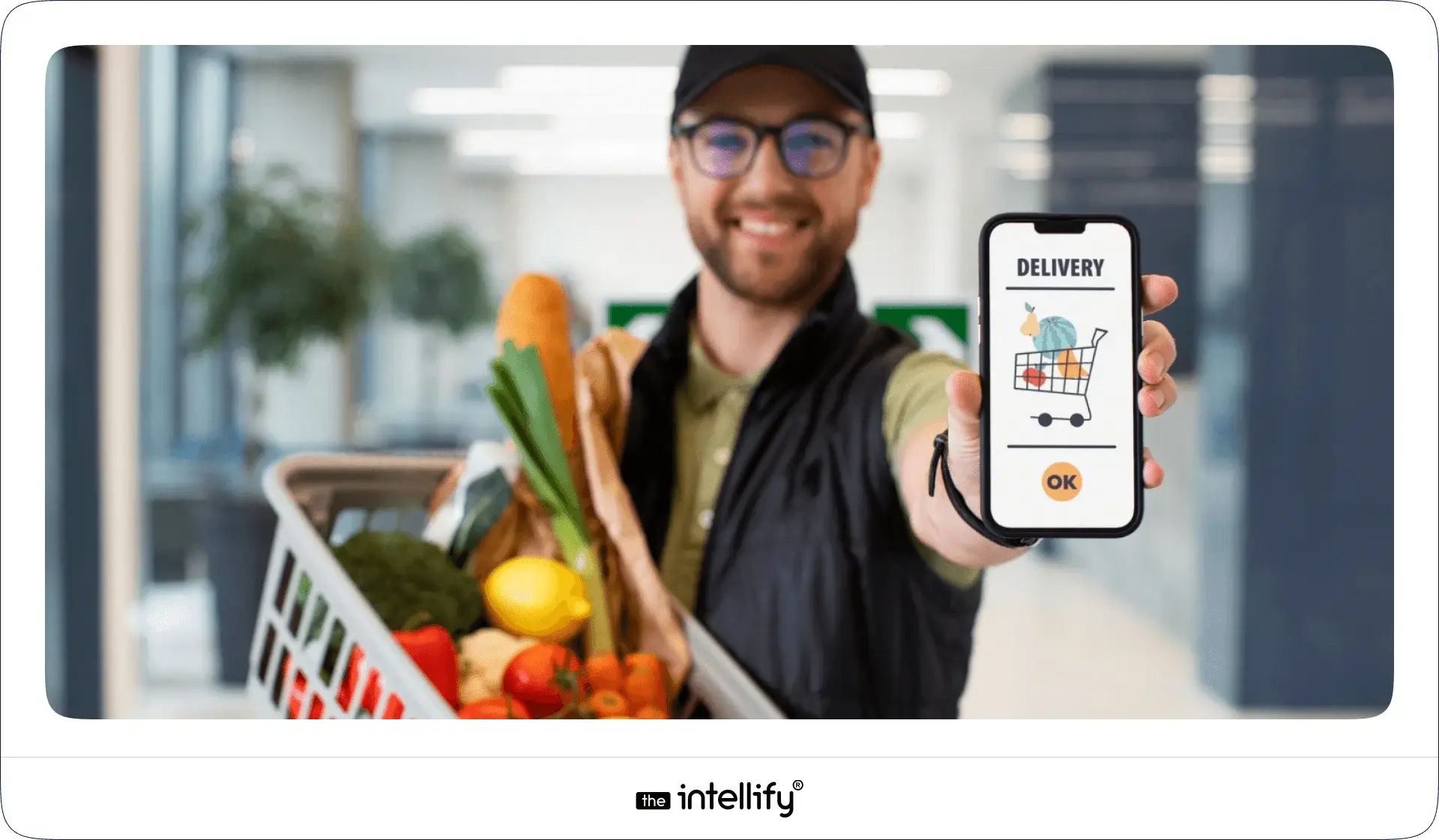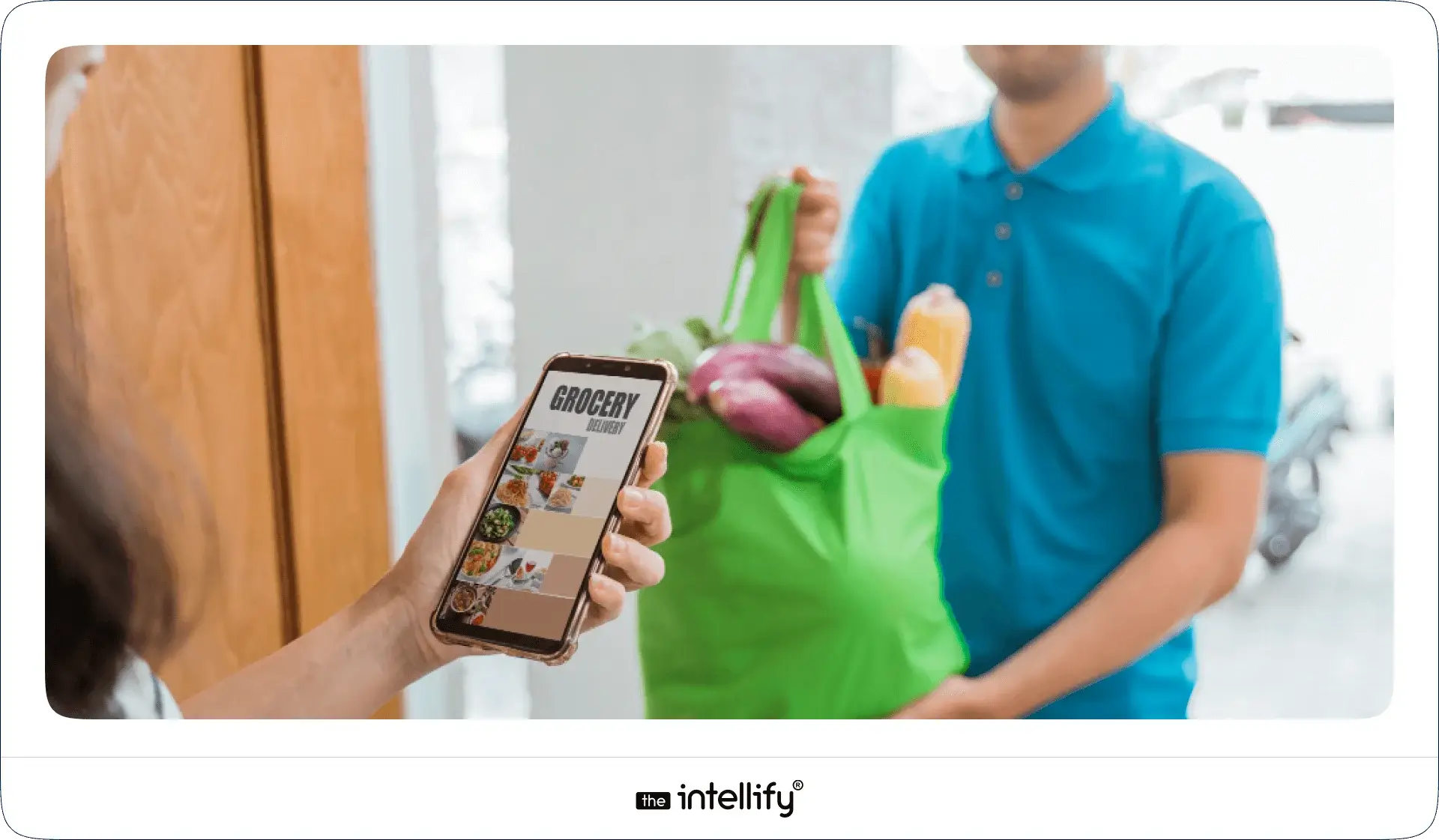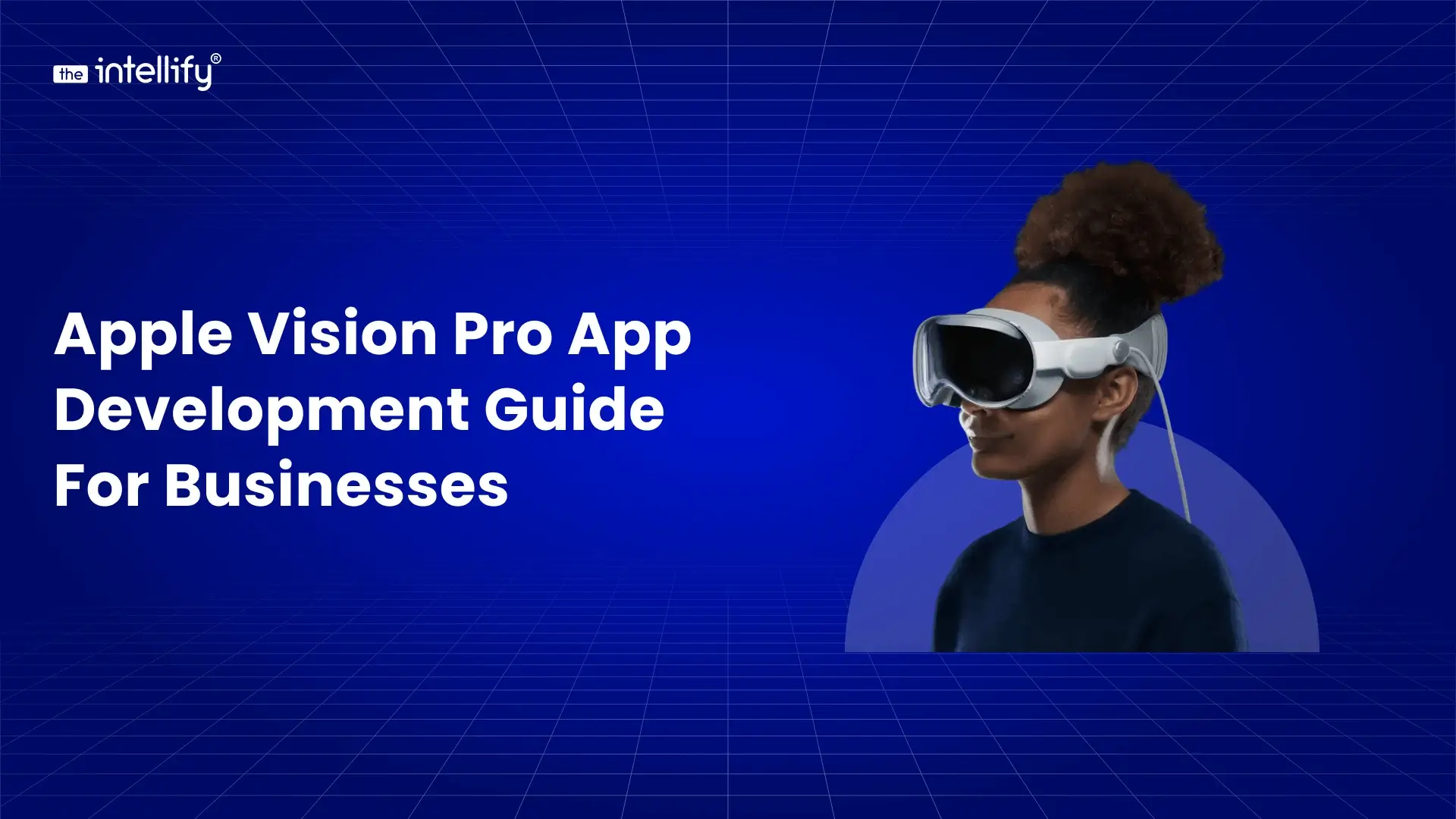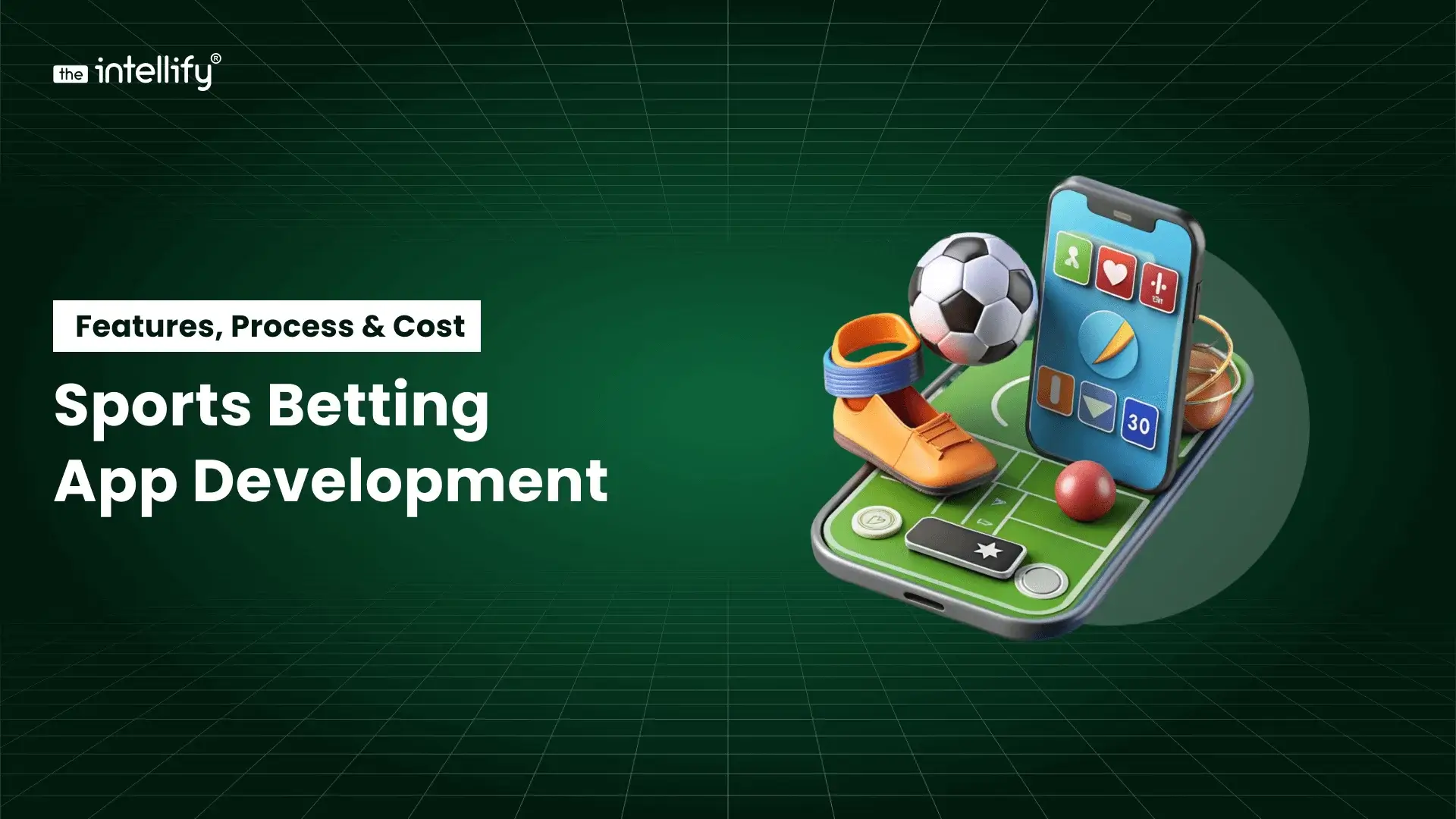Grocery Delivery App Development: Cost, Features, & Tech Guide

By Shravan Rajpurohit
November 28, 2025

Summary:
In this blog, we explore how to build an on-demand grocery delivery app development in 2026, from key features and tech stack to cost estimates, business models, and scaling strategies. Whether you’re a startup or established retailer, you’ll get a clear roadmap to launch and grow a grocery-delivery platform that wins in today’s competitive market
The Boom of On-Demand Grocery Delivery in 2026
The grocery delivery scene is changing fast, and we’re expecting even bigger shifts in 2026. Today, grocery delivery apps have become a crucial part of our shopping routines, offering a level of convenience and efficiency that traditional methods just can’t compete with. In this blog, we’ll explore everything about grocery delivery app development, from must-have features to development costs and upcoming trends.
What Is an On-Demand Grocery Delivery App?

An on-demand grocery delivery app is a platform that lets users shop for groceries right from their smartphones, with products delivered straight to their doorsteps. It links customers, grocery stores, and delivery personnel smoothly, creating a convenient shopping experience.
Why It Matters for Businesses in 2026
With more shoppers choosing online options, having an on-demand grocery delivery app is vital for businesses that want to stay competitive. Come 2026, these apps will be even more essential, helping retailers connect with a wider audience while improving customer loyalty.
Types of Grocery Delivery Apps
1. Inventory-led model: Customers shop from a specific store that manages its inventory.
2. Marketplace model: Third-party apps that bring together various stores, offering users a larger selection.
3. Hyperlocal delivery model: Concentrates on quick deliveries from local stores.
4. Store-pickup model: Let users shop online and collect their groceries at the store.
How an On-Demand Grocery App Works
Customer App Flow
1. User Registration: Customers sign up and create an account.
2. Product Browsing: Users browse available items and add them to their carts.
3. Order Placement: After making selections, customers move to checkout.
4. Payment: Secure payment methods make transactions smooth.
5. Tracking: Users can track their orders in real time until they arrive.
Merchant/Store Flow
1. Product Listing: Merchants keep their inventory updated and list products on the app.
2. Order Reception: They get notified of orders from customers.
3. Fulfillment: Merchants prepare orders for delivery.
4. Notification: When ready, they alert the delivery partners.
Delivery Partner Flow
1. Task Assignment: Delivery partners get notifications about new orders.
2. Route Optimization: They optimize their routes to ensure quick deliveries.
3. Pickup & Delivery: Pick up the order from the merchant and deliver it to the customer.
Technology That Makes It Work
Modern grocery delivery apps tap into technologies like GPS for routing, in-app messaging for seamless communication, and payment gateways for secure transactions.
Must-Have Features for Grocery Delivery Apps

Customer App Features
- Easy onboarding: Quick account creation and login.
- Smart search: Helps users find products rapidly.
- Real-time inventory: Instantly displays available items.
- Secure payments: Multiple options ensure safe transactions.
- Live order tracking: Users can follow their delivery status in real time.
- Reorder options: Let users easily purchase their frequently bought items.
Delivery Partner App Features
- Task assignment: Clearly outlines delivery tasks for partners.
- Route optimization: Suggests the best paths to cut delivery time.
- Earnings dashboard: Keeps track of daily earnings for partners.
- Status updates: Allows partners to keep everyone informed of their delivery progress.
Admin Panel Features
- Order management: Tracks all incoming and outgoing orders.
- Delivery management: Ensures effective coordination of all delivery partners.
- Inventory control: Monitors stock levels and alerts for low inventory.
- Analytics dashboard: Provides valuable insights into sales and customer behaviors.
Advanced Features
- Personalized recommendations: Tailors product suggestions based on user behavior.
- AI-powered suggestions: Leverages AI to improve shopping experiences.
- Smart inventory prediction: Forecasts demand to keep stock levels balanced.
- Wallet & loyalty points: Builds customer retention through rewards.
- Multi-vendor support: Enables various stores to sell through one app.
Tech Stack for Grocery Delivery App Development
Mobile Technologies
You can use native technologies like Swift for iOS and Kotlin for Android, or go for cross-platform solutions like Flutter and React Native.
Backend Technologies
Options like Node.js, Ruby on Rails, or Django offer solid frameworks for server-side development.
Database Options
MySQL, PostgreSQL, or MongoDB are popular for managing user data efficiently.
APIs & Integrations
Integrating third-party APIs for payments, GPS tracking, and analytics can boost the app’s functionality.
Cloud Hosting & Security
Cloud services like AWS or Google Cloud ensure you have scalable and secure hosting.
Grocery Delivery App Development Process

- Market Research & Planning: It’s crucial to identify your target audience and market trends to guide development.
- UX/UI Design: Designing a user-friendly interface is key to enhancing customer satisfaction and retention.
- App Development: This phase covers the actual coding of the app, based on design and requirements.
- API Integration: Integrating necessary APIs for payments, notifications, and mapping services is vital for app performance.
- Testing & Quality Assurance: Thorough testing ensures that your app provides a bug-free user experience.
- Deployment: The app gets launched on app stores for everyone to access.
- Launch Strategy: A solid marketing strategy is essential to generate excitement around your app’s launch.
- Maintenance & Scaling: Ongoing updates and improvements keep your app relevant and efficient.
How Much Does It Cost to Build a Grocery Delivery App?
Cost Breakdown by App Complexity
- Basic app: $30,000 – $50,000
- Moderate app: $50,000 – $100,000
- Advanced App: $100,000+
Factors That Influence Cost
- Complexity of features: More features mean more development work.
- Location of the development team: Rates can vary depending on the region.
- Technology stack: Some technologies may come with a higher price tag.
Extra Costs to Consider
- Marketing expenses
- Ongoing maintenance and updates
- Server and Hosting fees
Revenue Models for Grocery Delivery Apps
- Commission Model: Charge a percentage on every sale made through the app.
- Delivery Fee: Implement a delivery fee structure to cover logistics costs.
- Subscription Plan: Offer a monthly or yearly subscription for free deliveries or exclusive perks.
- Surge Pricing: Adjust prices during peak demand times for better service efficiency.
- In-App Ads & Brand Promotions: Partner with brands for promotions and ads within the app, generating additional revenue.

Common Challenges & How to Solve Them
1. Inventory Management
Solution: Use smart inventory tools to keep stock levels in check.
2. Delivery Speed
Solution: Leverage route optimization technology to accelerate deliveries.
3. User Retention
Solution: Develop loyalty programs to encourage repeat customers.
4. Cart Abandonment
Solution: Implement reminders and incentives to prompt completed purchases.
5. Peak-Time Order Handling
Solution: Adjust staffing and delivery resources during busy hours.
Future Trends in Grocery Delivery (2026-2030)
- AI in Personalization: AI will enhance personalized shopping experiences based on individual user data.
- Dark Stores & Micro-Fulfillment: Dedicated fulfillment centers will speed up processing times.
- Drone & Automated Delivery: New technologies will enable faster delivery options.
- Voice Ordering: Voice-activated features will streamline the ordering process.
- Ultra-Fast Delivery (10-Minute Model): Advancements aim to make minute-by-minute delivery a reality.
Real Business Use Cases of Grocery Delivery App

Retail Chains
Big names like Walmart are integrating delivery apps for a seamless customer experience.
Local Supermarkets
Smaller stores can use delivery apps to stay competitive in the digital space.
Statups
New businesses can capitalize on emerging trends for quick market entry.
D2C Brands
Direct-to-consumer brands are increasingly adopting delivery apps to enhance services.
Why Choose The Intellify for Grocery Delivery App Development
Domain Expertise: Our team has a deep understanding of the grocery delivery sector and offers tailored solutions.
Strong Technology Skills: We utilize the latest technology to create robust, user-friendly apps.
Fast Delivery & Quality: We prioritize quality and speed, ensuring your app is ready on schedule.
Long-Term Support & Scaling: After launching, we provide ongoing support and solutions for scaling your app as your business grows.
Conclusion
Investing in grocery delivery app development in 2026 presents vast opportunities for businesses. With improved customer experiences and new revenue streams, the advantages are plentiful. As technology continues to advance, staying ahead will be crucial for success.
If you’re looking for a personalized roadmap to create your own grocery delivery app, reach out to The Intellify today!
Frequently asked questions (FAQs)
1. What does an on-demand grocery delivery app do and how does it work for users and businesses?
An on-demand grocery delivery app allows users to browse, order, and receive groceries at their convenience while connecting customers to stores and delivery partners, streamlining the shopping process.
2. How much does it cost to build an on-demand grocery delivery app in 2026?
The cost typically ranges from $30,000 to $100,000 based on the app’s complexity and features.
3. What features are essential for a successful grocery delivery app?
Key features include smart search, secure payments, live order tracking, and easy reorder options.
4. How long does it take to develop a grocery delivery application from scratch?
It’s generally a 3 to 6 months process, depending on how complex the features are.
5. Which technologies are used to build a grocery delivery app?
Common technologies include mobile frameworks like React Native, backend systems like Node.js, and databases like MongoDB.
6. How do grocery delivery apps make money and stay profitable?
Revenue can come from delivery fees, commissions on sales, subscription plans, and in-app advertisements.
7. Can I build a custom grocery delivery app like Instacart, Blinkit, or BigBasket?
Absolutely! With the right development team, you can create a tailored grocery delivery app akin to those successful platforms.
8. Why should I hire a professional grocery delivery app development company for my project?
A professional team ensures high quality, timely delivery, and expert knowledge of market trends, which is crucial for a successful product.

Written By, Shravan Rajpurohit
Shravan Rajpurohit is the Co-Founder & CEO of The Intellify, a leading Custom Software Development company that empowers startups, product development teams, and Fortune 500 companies. With over 10 years of experience in marketing, sales, and customer success, Shravan has been driving digital innovation since 2018, leading a team of 50+ creative professionals. His mission is to bridge the gap between business ideas and reality through advanced tech solutions, aiming to make The Intellify a global leader. He focuses on delivering excellence, solving real-world problems, and pushing the limits of digital transformation.


Apple Vision Pro App Development Guide for Businesses
Summary: This blog breaks down Apple Vision Pro app development in a simple, practical way for businesses exploring AR and VR app solutions. It explains what the device can do, where it fits across industries like healthcare, retail, education, and real estate, and how the full development process works from concept to launch. You’ll also […]


Sports Betting App Development: Features, Process & Cost
Summary: This blog offers a complete guide to sports betting app development, explaining how to create a secure, feature-rich, and user-friendly betting platform. It discusses essential features like live betting, multiple payment options, and responsible gambling tools, along with the full development process, cost factors, and future trends such as AI, AR/VR, and blockchain integration. […]


How to Develop an eCommerce App: Guide for Brands & Retailers
Summary: Thinking about building an eCommerce app for your brand in 2025? This blog walks you through everything you need to know about eCommerce app development, from defining your business goals and choosing the right tech stack to designing a seamless shopping experience your customers will love. You’ll also learn about the must-have features, development […]


Apple Vision Pro App Development Guide for Businesses
Summary: This blog breaks down Apple Vision Pro app development in a simple, practical way for businesses exploring AR and VR app solutions. It explains what the device can do, where it fits across industries like healthcare, retail, education, and real estate, and how the full development process works from concept to launch. You’ll also […]


Sports Betting App Development: Features, Process & Cost
Summary: This blog offers a complete guide to sports betting app development, explaining how to create a secure, feature-rich, and user-friendly betting platform. It discusses essential features like live betting, multiple payment options, and responsible gambling tools, along with the full development process, cost factors, and future trends such as AI, AR/VR, and blockchain integration. […]


How to Develop an eCommerce App: Guide for Brands & Retailers
Summary: Thinking about building an eCommerce app for your brand in 2025? This blog walks you through everything you need to know about eCommerce app development, from defining your business goals and choosing the right tech stack to designing a seamless shopping experience your customers will love. You’ll also learn about the must-have features, development […]
0
+0
+0
+0
+Committed Delivery Leads To Client Satisfaction
Client Testimonials that keep our expert's spirits highly motivated to deliver extraordinary solutions.


















